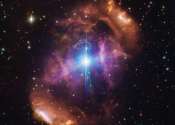Potential signs of 'interacting' dark matter suggest it is not completely dark after all
Astronomers believe they might have observed the first potential signs of dark matter interacting with a force other than gravity.

Astronomers believe they might have observed the first potential signs of dark matter interacting with a force other than gravity.
Astronomy
Apr 14, 2015
78
4032

Astronomers led by the University of Warwick have identified the oldest star in our galaxy that is accreting debris from orbiting planetesimals, making it one of the oldest rocky and icy planetary systems discovered in the ...
Astronomy
Nov 5, 2022
2
735

A team of astronomers from The University of Manchester, together with collaborators from the Centro de Astrobiología and the Deep Space Network, Spain and the Universidad Nacional Autónoma de México, have detected a rare ...
Astronomy
May 13, 2016
3
296

An international team of astronomers led by Yale University and the University of California-Santa Cruz have pushed back the cosmic frontier of galaxy exploration to a time when the universe was only 5% of its present age.
Astronomy
May 5, 2015
70
3577

An international team of astronomers has identified a record breaking brown dwarf (a star too small for nuclear fusion) with the 'purest' composition and the highest mass yet known. The object, known as SDSS J0104+1535, is ...
Astronomy
Mar 24, 2017
6
795

Astronomers have precisely measured the strength of a fundamental force of Nature in a galaxy seen eight billion years in the past.
Astronomy
Nov 15, 2016
4
1399

(Phys.org) —A dormant volcano—a supermassive black hole—lies at the heart of our galaxy. Fresh evidence suggests that it last erupted two million years ago.
Astronomy
Sep 23, 2013
5
0

(Phys.org) —A mysterious X-ray signal has been found in a detailed study of galaxy clusters using NASA's Chandra X-ray Observatory and ESA's XMM-Newton. One intriguing possibility is that the X-rays are produced by the ...
Astronomy
Jun 24, 2014
18
0

When astronomers looked at a stellar pair at the heart of a stunning cloud of gas and dust, they were in for a surprise. Star pairs are typically very similar, like twins, but in HD 148937, one star appears younger and, unlike ...
Astronomy
Apr 11, 2024
0
115

Red dwarfs are the coolest kind of star. As such, they potentially allow liquid water to exist on planets that are quite close to them. In the search for habitable worlds beyond the borders of our solar system, this is a ...
Astronomy
Oct 16, 2020
0
925